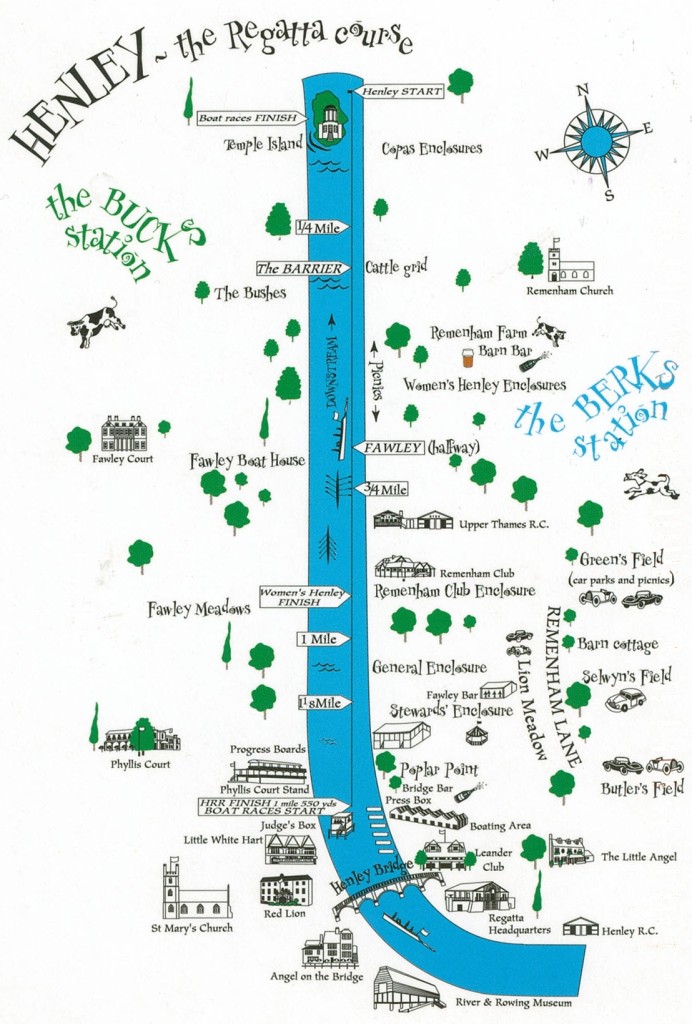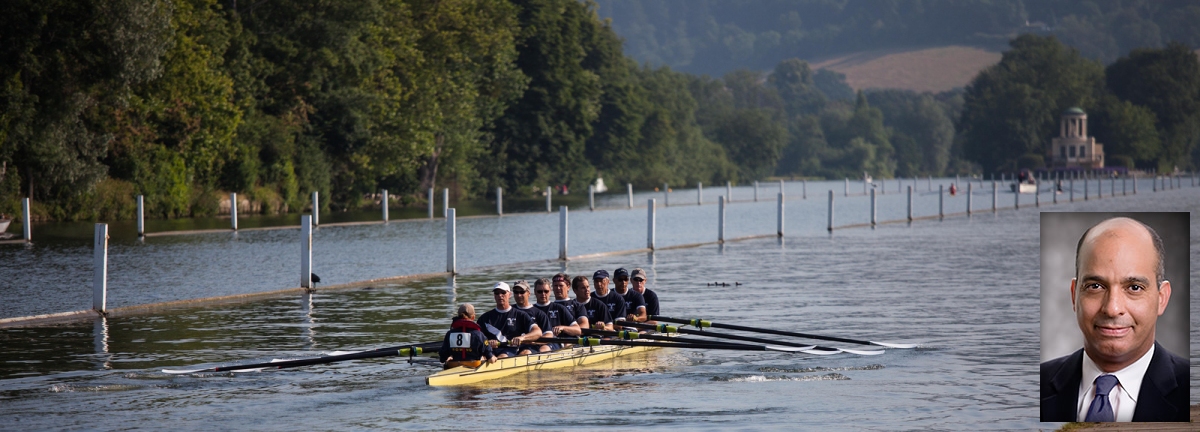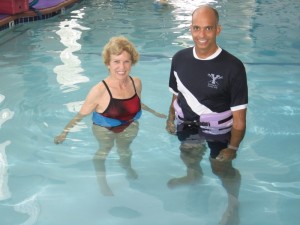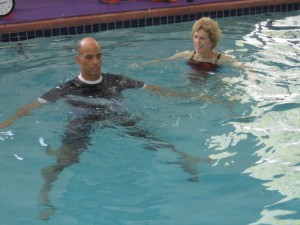From 1980 to 1983, Bill Funderburk rowed for Yale in the heavyweight crew boat. The first seat closest to the coxswain is called “Stroke,” and it was Bill’s job in his junior year to hold that first position in one of the varsity boats and establish the rhythm of the rowers. Every year, the Yale-Harvard race was the annual highlight. If the crews won there and had completed a stellar season, Yale funded a trip to row in the Henley Royal Regatta, the most prestigious place in the world for rowing just as Wimbledon is that place for tennis. Film goers were introduced to that world of privileged exclusivity in “The Social Network.” Bill and each of his teammates participated at least once in that illustrious race on the Thames, 30 miles from London.
Bill had a torn labrum in the hip and the joint was bone on bone. He was plagued with back pain and dysfunction associated with the hip, and it was painful to sleep, bend or sit. In mid-December, 2012, Bill had total hip surgery. Then, after non-stop support from his wife Felicia, he came to CompletePT in early January to begin his comeback. His goal was to meet a qualifying standard time for 1000 meters on a rowing machine ergometer by May 1st so that he could return this July with his Class of ’83 Yale teammates in a masters race at Henley.
Bill did twenty pool sessions with us. A large, muscular athlete, Bill needed to wear two flotation belts in order to be upright in the pool without his chin touching the water. His therapist strapped a CompletePT belt on him, the most buoyant of the belts and also added a second belt to counteract the downward pull of his muscle density. He did deep-water running and powerwalking for aerobic fitness in our 7-feet deep pool. At 6’4″, he needed our newly-remodeled pool — he would have been dragging his feet on the bottom of the old one that was only 6′ deep. Then he stretched, using our double bar system that protected him from violating his total hip surgery precautions regarding movement. Next he did some kicking exercises to strengthen core and leg muscles. In shallow water, a flotation cuff was put around his ankle to help increase the range of motion of that post-surgical hip as he did standing leg exercises. Our licensed physical therapists will determine when it is time to switch to adding resistance pieces around the ankles to increase strength.
During the pool therapy, he regained much of his strength and mobility. On May 1st, he beat the qualifying standard by four seconds and earned his seat in the boat!
Bill rowed out of the iconic Long Beach Rowing Association and received support to get actual meters on the water, something crucial to regaining a sense of balance and being able to blend with his Yale class teammates during the week of training prior to the race. But his hip grew stiff from having stopped his physical therapy. Bill returned to CompletePT for the next phase of his rehabilitation. He sensed he would need to fight for the remaining range of motion and athletic capability that was still not quite available to him. He trained hard both in the pool and on the water with LBRA and joined his 1983 Yale teammates in Henley for the race on July 13th.
“The race is so much more than just about rowing,” said Bill. “It’s clearly as much of a mind and spirit journey as it is a physical journey. It’s not about me but every one of the guys in my boat. I had to learn to surrender to and trust my teammates, and they had to do the same. Every second you’re rowing with seven other people, you have to be synchronized with them, be part of something greater than being an individual. That was what I yearned to relive and I knew that’s what all eight of us were going to get to relive.”
There was a time between 1977 and 1984 when Yale had a dynasty in the collegiate heavyweight rowing world. Undefeated seasons were the norm and the expectation not the exception. All of Bill’s teammates had rowed at Henley previously and they were all elite college oarsmen, even those, like Bill, who were walk-ons (not recruited) in their freshman year. Everyone had had at least one undefeated season. They were all looking forward to experiencing the Henley Regatta again.
Henley is unique in that only two boats can fit on the Thames at a time, so each boat is going heads up with only one other boat. “There are boats there from around the world,” said Bill. “It’s a great chance for rowers who have stayed in shape and who want to relive old memories of having rowed at what is viewed as the pinnacle of rowing.”
Bill had learned over his rowing career that you never knew if your spirit was going to be broken during a race and that what the mind was saying you could or couldn’t do was the most important thing. His hip was tight prior to the race. Another teammate who had had heart surgery the year before was experiencing atrial fibrillation on and off.
“We could have been a little more conditioned,” said Bill. But none of that mattered. “The state of mind was: We don’t care about your hip – that’s a lame excuse. Or heart. That doesn’t matter either. We’re going to dig down as a team and find whatever strength is required.”
The pace of a rowing race is similar to that of a swimmer going longer than 100 meters where the first lap can be the fastest, then you settle into a pace where you can stay aerobic for 3 minutes to 3 ½ minutes before using everything you’ve got for the finish.
Race day had a slight tail wind and the water was very still. In the semi-finals, Yale rowed against Quintin Boat Club. The first 20 strokes of a race is where rowers like to establish their fast speed and dominance over their opponents. After the first minute, the Yale ’83 crew — rowing as the Bulldog Rowing Club — was ½ length ahead, but then their opponent hit a good rhythm and reduced the deficit to three feet.
“When a crew starts to row back on you, they can break the other team down mentally,” said Bill. “We saw them push ahead by a few seats, but then all of us rose up together and dug our oars in harder. We collectively summoned up the courage to push back against the pain of such high-intensity work. We rowed back through the other crew to win it by a canvas. That’s like winning by a head in horse racing.”
As it turned out, the semi-finals race proved to be the highlight experience for the Bulldogs. They got to re-experience the sensation of fighting back with all you’ve got and winning.
The finals were against Crabtree Rowing Club, which had multiple classes of Cambridge University rowers. Half the team members had rowed in the 1976 or 1980 Olympic Games and two were Olympic medalists. They had been practicing together twice a week for six months. By contrast, the Yale alumni team had rowed together in the boat for just one week.
“But put aside those excuses. They just beat us,” said Bill. “We stayed even with Crabtree for the first 45 seconds to a minute. At the midway point, we were down by two-thirds of a length and that surprised them. They had won their previous races easily. We were making them work for the win. They gradually pulled away. We tried to take the stroke rate up and challenge them, but they ended up winning by a length and a half.”
Yale’s times were very competitive. They won their semi-final in a time of 3:11, and in the final on the same day they rowed an even faster time of 3:08, one of the fastest times recorded by any age group boat during the whole regatta.
Bill’s former roommate at Yale, Jim McGlone, rowed Stroke on the boat this time at Henley. (See him at the front of the boat in the photo above.) Bill shared Jim’s comments:
“The famous boat builder George Pocock described rowing the following way: ‘It’s a great art, is rowing. It’s the finest art there is. It’s a symphony of motion. And when you’re rowing well, why it’s nearing perfection. And when you near perfection, you’re touching the Divine. It touches the you of yours. Which is your soul.’ So we returned to Henley a band of brothers to enjoy our slice of heaven. As we age we accept each other for our human frailties and enjoy even more the symphony of motion Pocock so eloquently wrote about. I believe Bill was motivated by this feeling and I thank CompletePT for guiding my friend through his recovery which enabled us all to touch the divine for that brief moment!”
Home from the excitement of Henley, Bill has begun the final phase of his rehab program at CompletePT, where he will be expected to perform running and jumping exercises in chest-deep water before the end of his treatment.
William W. Funderburk, Jr., partner at Castellón & Funderburk LLP, graduated from Yale University and from Georgetown University Law Center. He is admitted to practice law in California, District of Columbia and Pennsylvania. Bill was the first African-American rower for Yale to go to the Henley Royal Regatta.
Lynda Huey, M.S., founder of CompletePT and Huey’s Athletic Network, is a former athlete and coach whose own injuries led her into the water to find fitness and healing. She was educated at San Jose State University where she starred on the track and field team during its golden years. Lynda is the author of four books on water exercise and water rehabilitation.







